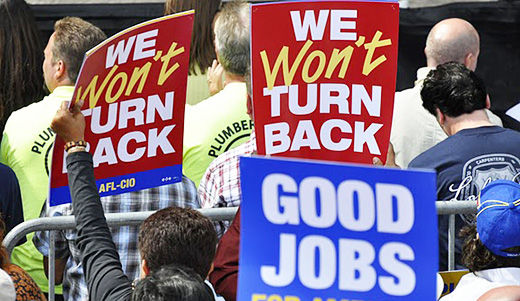
In his Labor Day speech to union members in Milwaukee the president, aiming for a serious reduction in the 9.6 percent unemployment rate, proposed a new $50 billion road, rail and airport re-building plan.
“This will not only create jobs immediately, it’s also going to make our economy hum over the long haul,” Obama told 10,000 cheering union members.
Republicans immediately attacked the plan with House Minority leader John Boehner, R-Ohio describing it as a ‘doubling down’ on the first $862 billion stimulus plan that he said was a “failure.”
Observers drew the connection between Republican opposition to infrastructure investment and the hope of big oil companies that they can avoid, as the president intends, their having to pay for infrastructure investment via reduced tax incentives. The initial $50 billion for infrastructure would come, under the president’s proposal, by scaling back oil and gas industry tax incentives.
The president’s plan would not allow the companies to take advantage of a manufacturing tax credit they now get and it would also eliminate some of the deductions they currently claim on income earned overseas.
The White House plan would rebuild 150,000 miles of roads, construct 4,000 miles of rail and rehabilitate 150 miles of runway.
“It’s just the message I want to hear,” said Don Burmester, a member of the International Association of Machinists, Local 66 in Milwaukee. “We need to get regular people back to work. I’ve seen the other party put political games ahead of anything decent to make the president look bad. We need to get the focus back on the economy and away from the political games.”
Most progressive commentators, including some who have criticized the president for moving too cautiously, applauded the proposal.
“President Obama finally began to vigorously push the kind of high-profile, re-build America infrastructure campaign that is absolutely essential,” said Bob Herbert of the New York Times. “The details of the proposal are less important than whether the proposal itself is a sign that Mr. Obama and his party are ready, at long last, to engage this awful economy with a sense of urgency.”
Herbert said the plan was too late to help Democrats in November but could pay off for them later.
The Nobel prize-winning economist Paul Krugman was less excited about the proposal, saying, essentially, that although it was a “good idea,” the plan, itself, is “much too small” and that “it won’t pass anyway.” Given that last reality Krugman wrote: “It makes you wonder why the administration didn’t propose a much bigger plan.”
Salon’s Joan Walsh said, “It’s probably not big enough, and even this modest bill probably won’t get the Republican and conservative Democratic support it needs to pass. But it’s good to see the president acknowledge that the government has a responsibility to continue to spend its way out of this recession, and not merely hinge his program on small business and research and development tax cuts.”
The president outlined a proposal for $200 billion in business tax cuts on Sept. 7. It would allow businesses to write off 100 percent of new investments in plants and equipment made between now and the end of 2011. While conservative economists and outlets like the Wall Street Journal are backing the plan, labor-backed economists are not as supportive.
Robert Reich, Secretary of Labor during the Clinton administration, ripped the president’s plan for the investment tax breaks, saying, “Big corporations are investing in automated equipment, robotics, numerically-controlled machine tools, and software. These investments are designed to boost profits by permanently replacing workers and cutting payrolls. The tax breaks Obama is proposing would make such investments all the more profitable.”
Labor-backed economists have said for many months now that if jobs are to be created in sufficient quantity, the economy needs another fiscal stimulus of several hundred billion dollars. Some have been calling for a massive federal jobs program like the ones that were so successful in the 1930’s.
Photo: PW Marguerite Hebrst

MOST POPULAR TODAY

Zionist organizations leading campaign to stop ceasefire resolutions in D.C. area


High Court essentially bans demonstrations, freedom of assembly in Deep South

Afghanistan’s socialist years: The promising future killed off by U.S. imperialism

Communist Karol Cariola elected president of Chile’s legislature






Comments